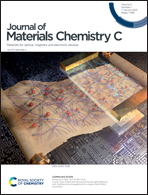The application of Ni and Cu-MOFs as highly efficient catalysts for visible light-driven tetracycline degradation and hydrogen production†
Abstract
Two coordination polymers, {[Cu3(tib)4(NO3)4(H2O)]·2NO3·2.96H2O}n (1) and {[Ni(tib)2]·2NO3}n (2), were synthesized by a solvothermal reaction using a flexible tripodal ligand, 1,3,5-tris(imidazol-1-ylmethyl)benzene (TIB), and metal salts; the polymers were characterized by X-ray diffraction, Fourier transform infrared spectroscopy, thermogravimetric analysis, X-ray photoelectron spectroscopy and UV-vis diffuse reflectance spectra. The two complexes exhibited excellent active performance for photodegradation of tetracycline (TC) and photocatalytic hydrogen evolution under visible light. Control experiments revealed clearly that the pH value plays an important role in TC degradation, especially in alkaline solution; 93.21% of tetracycline was degraded by complex 1 within 60 min. In addition, using a Pt cocatalyst, the visible-light-driven photocatalytic H2 evolution rate of complex 2 reached 681.66 μmol h−1 g−1. Moreover, the photocatalysts can remain stable and retain high photocatalytic activity after several cycles of reuse. These MOF-based photocatalysts will provide new efforts for environmental purification and hydrogen evolution.



 Please wait while we load your content...
Please wait while we load your content...